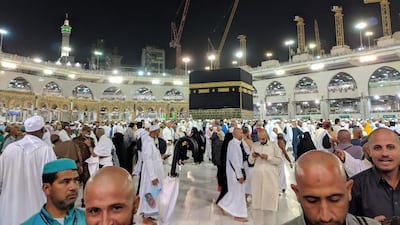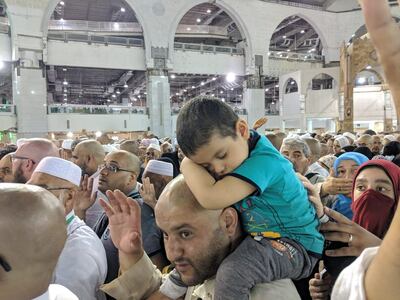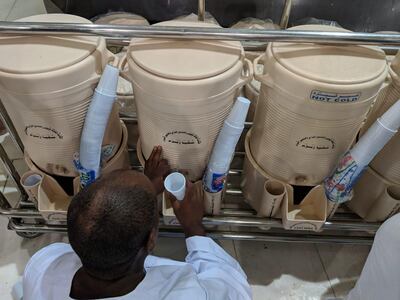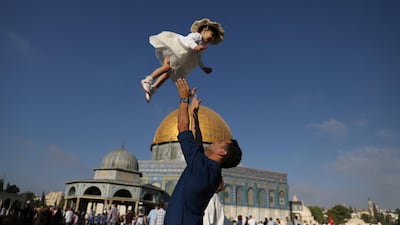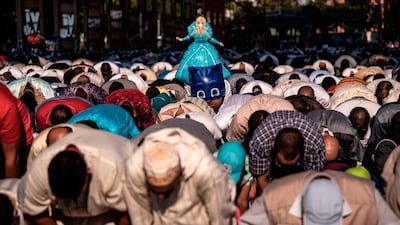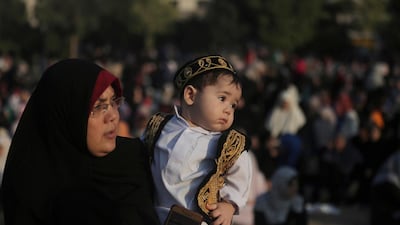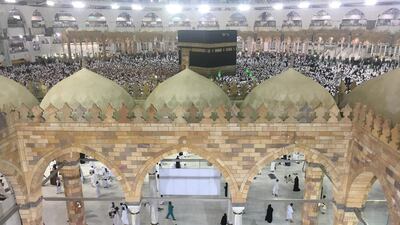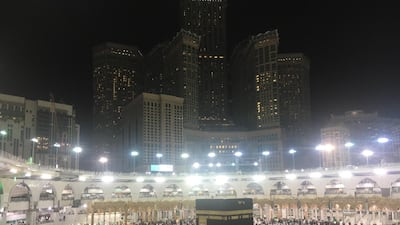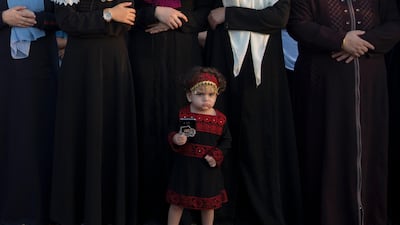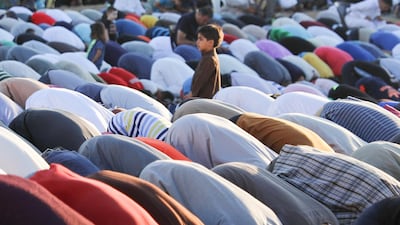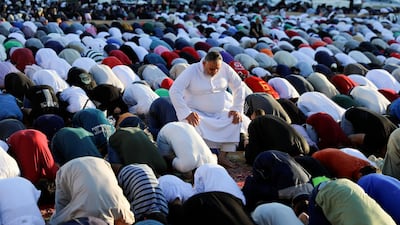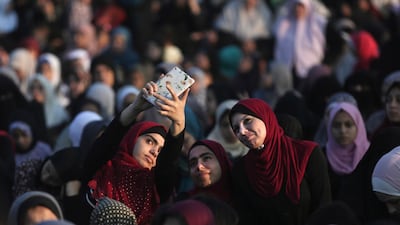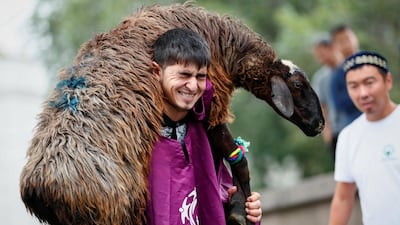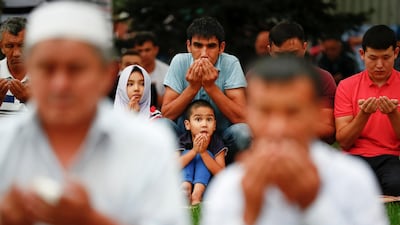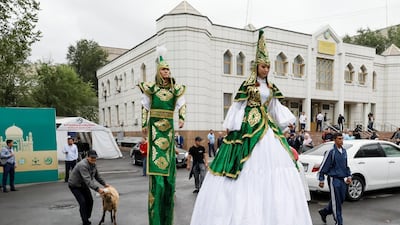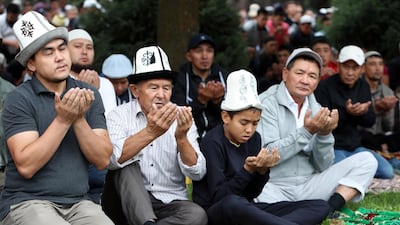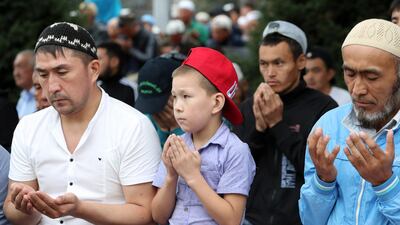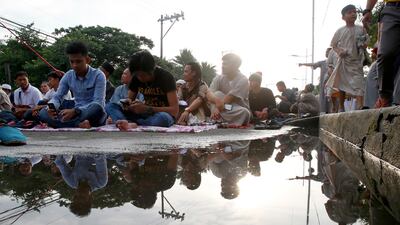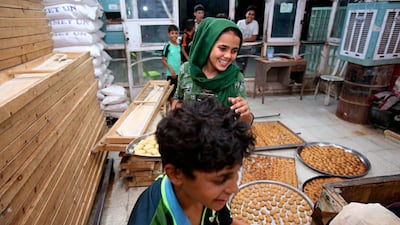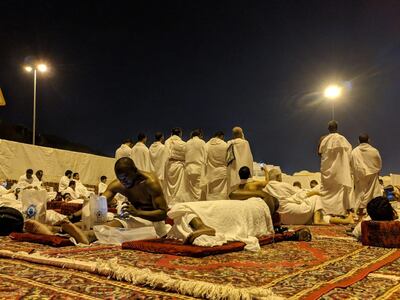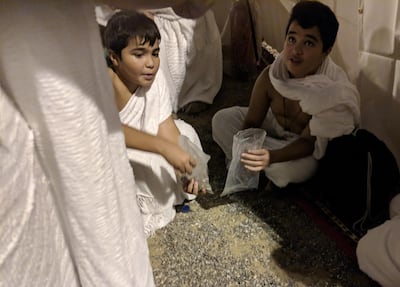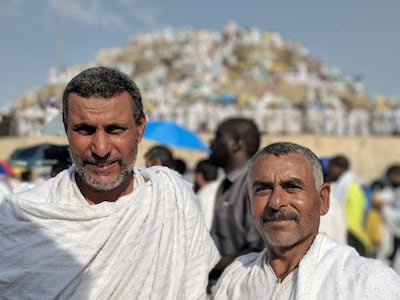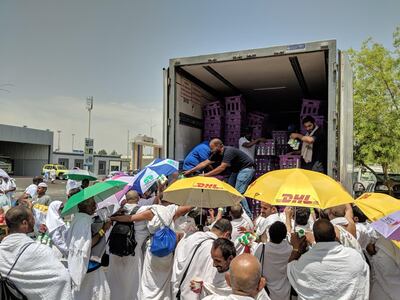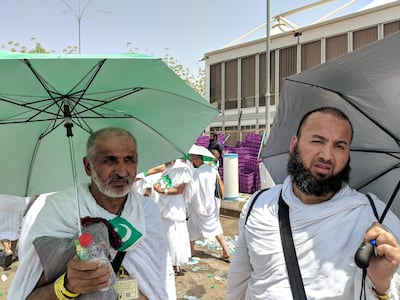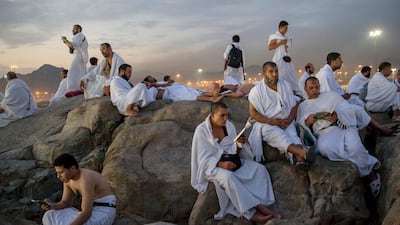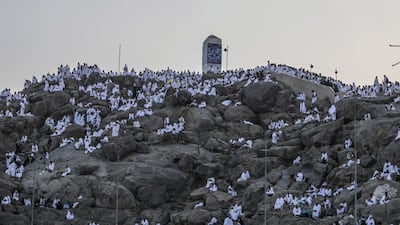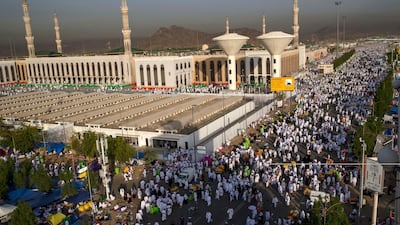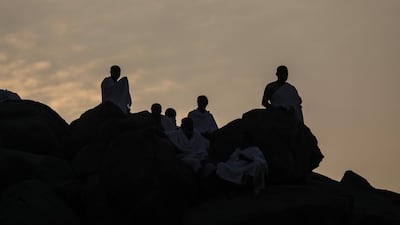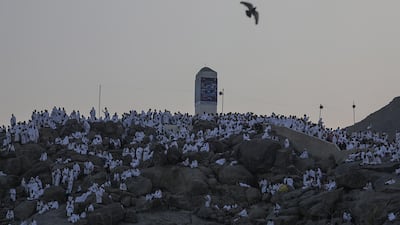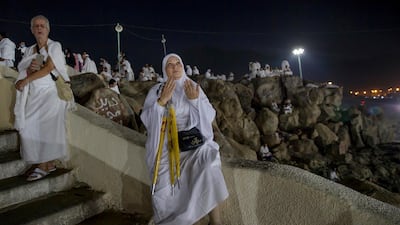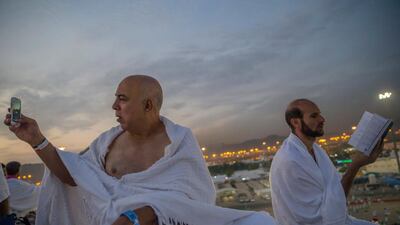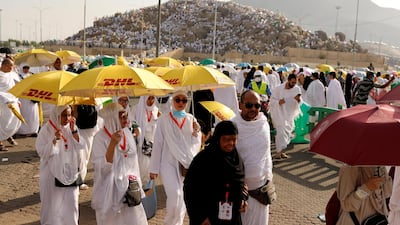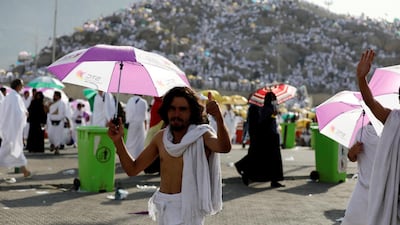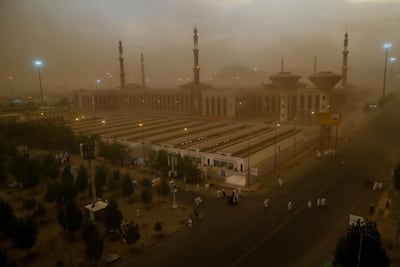• Watch: our Hajj video explainer
• Report: Devoted pilgrims scale Mount Arafat for Hajj pinnacle
• Report: Fourteen million pebbles - Hajj pilgrims stone the devil
More than two million Muslims from around completed their Hajj pilgrimage in Saudi Arabia. Recount their experiences with fellow Hajji Naser Al Wasmi below:
______________
18:00 Stoning of the Devil - watch
______________
Wednesday 04:15 Hajji at last
After the circumambulation, pilgrims head towards an expanse in the northern part of the mosque facing the Station of Ibrahim, where the imprint of the Prophet Abraham is set in a rock.
They say a prayer, then head on to the last step before the pilgrims become they become Hajjis, shaving their heads.
Makkah, even at 2 am, is alive. During Hajj shops never close, and neither do the barbershops.
Sameer, a barber working in a shop within 5 minutes from the Kaaba, takes a break and drinks tea.
“I have maybe shaved over a thousand people,” he said sipping on his milky tea, “this is the first time I have sat down in 8 hours.”
I beckon him to shave my head, he refuses my patronage saying “go somewhere else, I am too tired or wait 5 minutes”.
His technique is spotless, as someone who has done this, according to him, thousands of times just during Eid.
Shaving the head, a sign of transformation, is capped off with finally abandoning the white garments, signifying their journey of Hajj is coming to an end.
Returning to wearing normal clothes for those who have walked dozens of hours, pushed through sleepless nights and prayed relentless hours, is the moment of their elevation to Hajji or Hajjia, those who have performed Hajj.
______________
22:15 Circling the Kaaba
Pilgrims enter a trance as they circle the Kaaba: it hits most deeply around the second or third circumambulation.
The repetition of prayers slows the pace, with some groups shouting out for God to hear, others whispering with their chins tucked into their chest; all are praying.
A little boy rides on his father’s shoulders, lulled asleep by the music of the prayer.
There’s an ebb and flow to the circumambulation. It’s typically more free-flowing on the outer layer, furthest away from Kaaba. But it comes to a standstill at the point that crosses the Black Stone.
The body heat from thousands of pilgrims raises the temperature, but in openings in the crowd a breeze will pick up the spirits of those weary from the kilometres of walking.
______________
22:15 Taking the waters
The man is drinking zamzam water; coolers full of this are distributed around the sacred mosque. Pilgrims drink before performing the seven circumambulations.
______________
20:45 Performing Tawaf
A cool night is respite for many going from Mina to Makkah to perform tawaf, the circumambulation of the Kaabah.
The walk is only 20 minutes longer than the drive, as such pilgrims are taking this as their chance.
Meanwhile, read Naser's full report on how at least 14 million pebbles are being thrown at the devil today
______________
15:15 Shaved heads, a new start
Clumps of hair lay spewed across the floor of the ramp coming down from the structure of Ramy Al Jamarat.
Every colour of undyed hair imaginable recently abandoned is found rolling along the ramp, collecting in large clusters. It can be seen as a metaphor for the Hajj itself.
After tossing the pebbles, pilgrims descend from the Ramy Al Jamarat, having accomplished one of the great steps of the pilgrimage.
Tossing the pebbles is a transformative experience, both spiritually and physically, as pilgrims are now required to cut their hair.
But there isn’t a barber in sight. Many have come prepared for this exact moment.
With heads dangling over garbage bins, other pilgrims take blades to the tufts of hair of those willing.
Although it is not mandatory to shave your head, only to cut it short, most opt to shave it to signify their coming transformation into becoming a Hajji. For many, it’s a feeling of being born anew.
A man holds his newly shaved head, it’s not pinpoint work as patches of longer hair are still visible, and rubs his hand on his scalp.
“It feels good,” he jokes with his friends.
______________
12:30 Eid prayers in Makkah and around the world
_______________
08:30 Seven pebbles with one target: Satan
There should be only fourteen million pebbles thrown at the devil today, but some pilgrims may toss a few more for good measure.
Early on Tuesday morning, at Muzdaliffah, millions of Hajj pilgrims were squatting on the ground meticulously picking the pebbles for today's ritual - Ramy Al Jamarat.
"I want them to feel good when I throw it," says a boy at one of the surrounding Mina camps. His dad encourages him, but tells him to keep the pebbles small.
Today, many of the pilgrims walking from Muzdaliffah continued their trek through a convoluted network of walkways to ritual site. The paths funnel thousands of pilgrims hourly, each clutching a seven pebbles with one target: Satan.
As they approach the ramp to the first floor of the multi-leveled building, the pace becomes feverant, there rustling of the handful of pebbles can be heard distinctly from thousands as they approach the long oval wall representing the devil.
The throwing distance is up to the pilgrim's discretion, some toss from about 10 metres, others get as close as possible to the railings. The taller pilgrims at the front often intercept pebbles launched from a distance, but that doesn’t stop the flurry of chucks. Being 192cm, I of course was a victim.
“Allahu Akbar, Allahu Akbar,” an Egyptian man screams as he rapid-fires his remaining pebbles.
Rage can be seen in some, others are overwhelmed with vengeance, but all are highly emotional.
Pilgrims will return several more times over Eid to continue the stoning.
_______________
Tuesday 05:10 No sleep until Mina
Groups of pilgrims stop and line up together to perform the prayers they may have missed while walking towards Muzaliffah or on a bus.
The weather has dropped into the thirties and a light breeze gives respite to weary pilgrims.
Many will not sleep for the next 24 hours.
It's stop-and-go traffic from Muzaliffah to Mina. On each side of the road are seas of white cloth, pilgrims walking throughout the night towards the the tent city of Mina.
_______________
Tuesday 02:00 Gathering the pebbles
Pilgrims gather at Muzaliffah to gather the pebbles they will throw in the Ramy Al Jamarat in Mina.
A child takes a painstakingly long time choosing just the right size and colour stone at a crossing in between two dug out mountains.
"This is my favorite part," he says about the symbolic stoning of the devil that will take place during the three days of Eid.
For many there is no sleep tonight, some will even attempt to throw the stones at daybreak before heading to Makkah to perform some of the rituals ahead needed to increase the chance of successful Hajj.
_______________
21:50 Pilgrims on the move
Pilgrims leave in the millions, the buses in front of our camps haven't moved for 15 minutes.
Many have again opted to leave the way they came in: on foot.
Those returning back to Mina, via Muzaliffah, would have walked a total of 24km.
But pilgrims remain in good spirits, as someone from the walking crowd says "God will help us along the way, he will make the journey easy."
_______________
20:10 "I am glad to return home, and be called a Hajji"
For Ahmed and Hamdi, Egyptians on their first Hajj, this is a unique opportunity to absolve themselves to ask for God’s forgiveness and absolve themselves of all sins.
“All we can do is pray, and thank God for what we have, and hope he will give us paradise,” said Ahmed, who is in his 40s.
The men from Egypt have saved up for years working in Cairo at different odd jobs for a chance to perform the holy pilgrimage – the chance to do so will elevate their status both spiritually and socially.
“I am glad to return home, and be called a Hajji, God willing,” said Magdi.
Asked if they would have preferred to perform the Hajj during a cooler season, they said they will take what they can get.
“We are just happy at the opportunity, and God will make things easier,” Magdi said.
For many, choosing when they can perform Hajj is not an option. In Indonesia, the most populous Muslim nation and responsible for the largest Hajj constituency, the wait is 37 years to perform the pilgrimage.
Those who get the chance, come rain or shine as it did this year, will take it and hope they perform a succesfull Hajj.
Meanwhile, here's a longer report on the devoted pilgrims scaling Mount Arafat today.
_______________
19:15 Amid the cooling mist
Water spouts are set up around Mount Arafat to ensure the pilgrims stay hydrated. Others have carried Zamzam water with them, to keep hydrated from the blessed well.
Across the street a team of government workers spray a cooling mist on all who ask but they are not the only ones perform the goodwill gesture.
Youth punch holes in water bottles spraying pilgrims as they walk, some enter playful duels with each other as they squirt ice cold water from plastic bottles.
The aftermath of that could be felt underfoot, the sound of an endless stream of discarded plastic bottles covers the streets of Mount Arafat encampment.
Others take shade under trees or buildings and wait for the next stop of their pilgrimage.
_______________
17:40 Watch: On the foothills of Jabal Rahma
Pilgrims gather on the foothills of Jabal Rahma, where Prophet Mohammed gave his last sermon in 632CE.
Crowds are reaching fever pitch and 42-degree heat beats down on them. Water rains down on pilgrims cooling them as they pray.
Pilgrims feel closer to God at this point and feel God can hear their every prayer.
Crowd control is the biggest challenge for Hajj organisers, managing the hundreds of thousands of people converging on monuments in Makkah at one time.
_______________
17:00 Charitable spirit reaches fruit sellers
A fruit seller sets up shop on a busy intersection to sell fruit to pilgrims looking for a snack to energise them on their travels.
“Sometimes I sell, a lot of people think it is for free, but I am here to sell," said, Ahmed, 15, from Yemen. "The Saudi government and Islamic charities are handing out food for free.”
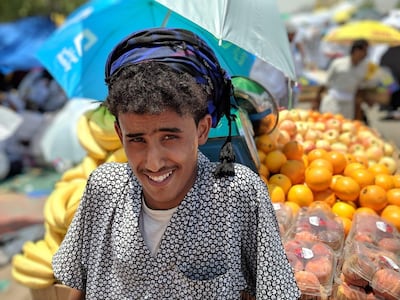
From ice cream to milk, the government has set up stalls throughout the streets to ensure the pilgrims stay hydrated, cool and well fed.
The goodwill rubs off on even the most staunch entrepreneur, the fruit-selling teenager.
“But people sometimes still want to buy. If they don’t have money I, of course, will give it to them,” he said.
_______________
15:40 Buttermilk quenches Hajj thirst
White clothes gather around a covered full lorry, packed to the brim with buttermilk. The two men inside distribute packs of four and packs of six for thirsty hands outstretched.
Imrad Mohammed and his father, both from Pakistan, drank the buttermilk under shade from umbrellas handed out by a Saudi company.
“We were able to get to the sermon in Masjid Namirah, it was so crowded. Now we rest, and so we’ll go to Jabal Rahma after a few hours. It’s very hot, but God willing we will try,” he said.
_______________
14:10 Pilgrims listen to sermon at Namirah Mosque
The Namirah mosque, which is located in Wadi Uranah, just two kilometres away from Jabal Rahmah, marks the location where the Prophet Mohammed camped during his final pilgrimage in 632 CE.
“I’m blessed to be here and be this close to God,” said a Malaysian man. The Saudi sitting next to him shared his umbrella as they listened to the sermon at noon.
“To be good, kind and patient is key to your successful pilgrimage,” the sermon said, blasted on speakers to reach the furthest reaches of the encampment.
After the gathering, many will head towards Jabal Rahma, a 70-metre hill and pray at the spot where the Prophet Mohammed gave his farewell sermon.
_______________
13:00 Roadside camping in Makkah
Many who cannot find their tent dwellings have set up makeshift enclosures to beat the heat on the side of the road.
Mount Arafat’s streets, void of life or structure throughout the year, turns into a sprawling metropolis of tents and moving umbrellas on the holy day.
A family has set up along a fence saying they will not spend the night here but that they will simply do the necessary and return to their encampments in Mina at sundown – typically another two-hour walk.
“I did this many years ago,” the patron of the family, Abdullah said, “this is how it was done in 1970 when I went with my father as a child.”
_______________
12:40 Staying cool in unfamiliar Saudi heat
The traffic between Mina and Arafat, where the two million pilgrims must go today, is at a standstill. Many who opted to walk the 12 km began picking up their pace to beat the noon sun raising the temperature to 40 degrees Celsius.
Ali Hamza, a Turkish pilgrim, cools his face with water from a mist shower set up on a light pile on the outskirts of the sprawling tent city of Arafat.
“We started early, but it was much hotter than we thought,” he said, “we thought maybe the rain from last night would cool the temperature, but I have never experienced this heat ever before.”
Many, like Ali, are unaccustomed to the heat typical of the Hejazi summer.
“But I must stay focused, and drink water, we are here for a purpose,” he said.
That purpose is to stand on Mount Arafat, or to remain in its premises, and recite prayers on the scene of the Prophet Mohammed’s last sermon.
The walk is often the fastest way for pilgrims to reach Arafat, where they will pray before heading to Muzdaliffah.
_______________
12:00 Beautiful Hajj pictures show pilgrims praying on Mount Arafat
_______________
10:45 From conflict to feeling reborn
Khalaf Aziz fled his native Syria three years ago and is performing his fourth Hajj, this one in honour of his grandmother who died earlier this year.
"My cousin died in an air strike and my uncle was shot to death, may they rest in peace. Two years ago, I performed Hajj for the former, and last year for the later," the 32-year-old from Deir Ezzor told Reuters. "This year, I am doing it for my grandmother."
Yemeni Qaboos Ghalib said he felt reborn performing Hajj for the first time: "I hope peace prevails in the Arab world in general and in Yemen specifically, and that the war ends."
_______________
07:30 Rainy night for pilgrims
Hajj pilgrims were greeted with rains over Mina with official Saudi weather forecasters warning of high winds in the mountains surrounding the holy sites.
Several hours of heavy rain and thunderstorms forced pilgrims to take cover in tents and trudge through puddles. Saudi Arabia's civil defence warned of possible flooding throughout the evening but denied it would result in adverse effects on the rituals.
WAM, the UAE state news agency, cited Mohammed Al Kaabi, Head of the UAE Hajj Mission, saying all Emirati pilgrims are fine and in good health.
_______________
Monday, August 20: Muslims to head to Mount Arafat
Monday will mark the pinnacle of Hajj. Muslims will stand on Mount Arafat and pray on the spot where the Prophet Mohammed gave his final sermon almost 1,400 years ago.
More than 2 million people will converge on a hill no larger than a football field and pray. That is the first event of Hajj that will require every pilgrim to be in the same place at a specific time, between noon and sunset.
Read the second report from Naser Al Wasmi in Makkah here
Here's what it is like on reaching the top:
_______________
Sunday, August 19: “Labaik Allahuma labaik” (“Here I am, God, here I am”)
The excitement of the crowds arriving in Jeddah was expressed in a myriad of languages, as passengers from Mumbai, Abu Dhabi and Jakarta waited in the immigration line at the King Abdulaziz International Airport.
But the languages of Indonesia, India and Bosnian gave way as the pilgrims joined together in a swelling prayer at the Hajj terminal. Together, they chanted “Labaik Allahuma labaik”, Arabic for, “Here I am, God, here I am.”
The prayer encapsulates Hajj for so many as they come to gain acceptance from God.
Read the first part of Naser Al Wasmi's journey here
_______________
What are the steps for Hajj?
Muslims follow the actions of Prophet Mohammed when he performed his Hajj in 632 CE. Those accompanying the Prophet observed his every move and these steps are performed in the same sequence today.
Before beginning Hajj, pilgrims must enter what is known as a state of Ihram, whereby they prepare their bodies and mind for the rituals ahead. This requires them to recite an intention and adhere to a certain dress code. Men must wear garments without stitching and cannot cover their heads, while women can wear stitched garments but cannot cover their face.
After entering Ihram, pilgrims begin their Hajj from the Kaaba, the holiest site in Islam as it holds the Masjid Al Haram, a structure in the middle of the Kaaba that Muslims believe was placed by prophet Ibrahim thousands of years ago.
As they approach the Kaabah, pilgrims must circumambulate in a counter-clockwise direction, meant to express the devotion of Muslims praying to one God.
They must then perform Sa’ey, whereby Muslims re-enact the journey by Hagar, the prophet Ibrahim's wife, as she went between two small hills in Makkah, Al Safa and Al Marwa, looking for water for her son Ismail. Muslims pace between the two points, in remembrance of the miracle whereby God caused a spring to well up from underneath an exhausted Hagar. It is today the Well of Zamzam.
Pilgrims then depart for Mina, five kilometres away, where they recite prayers and spend the night in the valley where prophet Ibrahim stoned the devil as he tried to lead him astray.
On the second day of Hajj, after the Fajr prayer in Mina, pilgrims make the journey to Mount Arafat, a 70-metre hill believed to be where the Prophet Mohammed gave his final sermon. Standing and praying on Mount Arafat is considered the peak of the pilgrimage.
_____________
Read more:
Hajj 2018 explained: A journey of a lifetime
_____________
Descending from Mount Arafat, pilgrims make their way to Muzdalifah, to the south of Mina, to pray and collect pebbles to perform the last steps of Hajj.
On the third day is Ramy Al Jamarat, a symbolic stoning of the devil takes place at three walls located in Mina.
From the fourth day, which is also Eid Al Adha, pilgrims will spend the three days of the festival stoning and praying. They end their Hajj with a ritual sacrifice of a sheep.
Tawaf Al Ifadha, whereby pilgrims go back to Makkah and circumambulate the Kaaba one final time, is the final step of Hajj.
